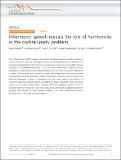Inharmonic speech reveals the role of harmonicity in the cocktail party problem
Author(s)
Ellis, Dan P. W.; Kawahara, Hideki; Popham, Sara F; Boebinger, Dana Lynn; McDermott, Joshua H.
Downloads41467-018-04551-8.pdf (1.434Mb)
PUBLISHER_CC
Publisher with Creative Commons License
Creative Commons Attribution
Terms of use
Metadata
Show full item recordAbstract
The "cocktail party problem" requires us to discern individual sound sources from mixtures of sources. The brain must use knowledge of natural sound regularities for this purpose. One much-discussed regularity is the tendency for frequencies to be harmonically related (integer multiples of a fundamental frequency). To test the role of harmonicity in real-world sound segregation, we developed speech analysis/synthesis tools to perturb the carrier frequencies of speech, disrupting harmonic frequency relations while maintaining the spectrotemporal envelope that determines phonemic content. We find that violations of harmonicity cause individual frequencies of speech to segregate from each other, impair the intelligibility of concurrent utterances despite leaving intelligibility of single utterances intact, and cause listeners to lose track of target talkers. However, additional segregation deficits result from replacing harmonic frequencies with noise (simulating whispering), suggesting additional grouping cues enabled by voiced speech excitation. Our results demonstrate acoustic grouping cues in real-world sound segregation.
Date issued
2018-05Department
Massachusetts Institute of Technology. Department of Brain and Cognitive SciencesJournal
Nature Communications
Publisher
Nature Publishing Group
Citation
Popham, Sara, et al. “Inharmonic Speech Reveals the Role of Harmonicity in the Cocktail Party Problem.” Nature Communications, vol. 9, no. 1, Dec. 2018. © 2018 The Authors
Version: Final published version
ISSN
2041-1723